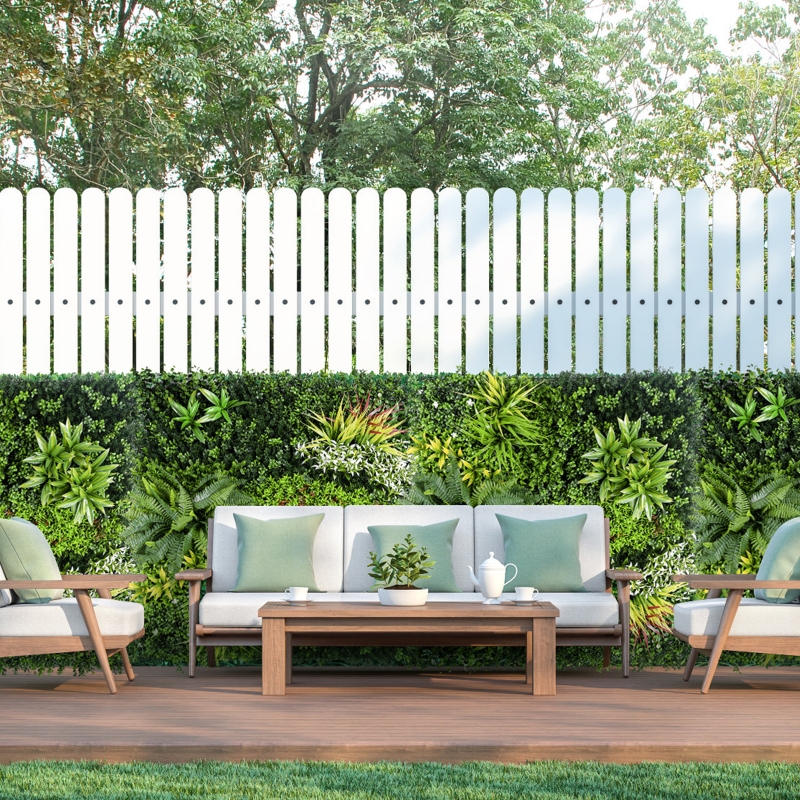Fruit-Bearing Plant Applications in 3D Artificial Vertical Gardens: Adding Color, Texture, and Natural Appeal to Wall Displays
Artificial vertical gardens provide a unique opportunity to incorporate the visual interest of fruit-bearing plants into spaces where real fruits might not thrive due to environmental constraints, limited sunlight, or maintenance challenges. By using designs inspired by a variety of fruiting species, these gardens can introduce vibrant colors, intriguing textures, and a sense of natural abundance without the need for watering, pollination, or harvesting. Below are strategies for integrating artificial fruit-bearing plants into 3D vertical gardens for a dynamic and lifelike appearance.

One of the most effective ways to create an engaging artificial fruit garden is by combining fruits of different shapes and sizes. This approach mimics the diversity found in natural ecosystems and adds depth to the arrangement.
Round Fruits as Focal Points: Use artificial plants with spherical fruits, such as those inspired by apples, oranges, or grapes, to draw attention. Place these designs at eye level or in central positions to serve as the main attraction of the garden. Their smooth, consistent shapes create a sense of balance and harmony.
Elongated Fruits for Vertical Interest: Incorporate artificial plants with oblong or cylindrical fruits, like those resembling bananas, chili peppers, or eggplants, to add height and movement. These designs work well in upper sections of the garden or along the edges, creating a sense of upward flow.
Clustered Fruits for Fullness and Texture: Introduce artificial plants with small, grouped fruits, such as those mimicking blackberries, raspberries, or elderberries, to fill gaps and add a sense of abundance. These clusters create a soft, organic look that contrasts with larger, solitary fruits.
Color is a key element in making artificial fruit gardens visually appealing. By selecting a mix of bright, bold hues and more subdued tones, you can create a balanced and eye-catching display that enhances the overall aesthetic of the space.
Bright, Bold Colors for Energy and Excitement: Use artificial fruits in vivid shades like red, yellow, or orange, such as those inspired by strawberries, lemons, or peppers, to add a pop of color. These hues work well in areas where you want to create a lively atmosphere, such as kitchens, dining rooms, or play areas.
Deep, Rich Colors for Drama and Sophistication: Incorporate artificial fruits in darker tones like purple, blue, or maroon, like those resembling plums, blueberries, or figs, to add depth and contrast. These colors create a sense of luxury and work well in formal spaces or as accents against lighter backgrounds.
Neutral and Earthy Tones for Balance and Naturalism: Introduce artificial fruits in shades of green, brown, or beige, such as those mimicking limes, avocados, or coconuts, to soften bright color schemes and add a touch of realism. These neutral tones serve as a bridge between bolder colors and prevent the garden from looking too artificial.
While fruits are the main attraction, foliage plays a crucial role in creating a natural and believable artificial garden. By mixing fruiting plants with different types of leaves, you can mimic the look of a thriving, organic ecosystem.
Broad, Green Leaves as a Backdrop: Use artificial plants with large, lush leaves, such as those inspired by banana plants, fig trees, or citrus trees, to provide a rich green foundation for the fruits. These designs create a sense of fullness and help the fruits stand out.
Variegated Foliage for Visual Interest: Incorporate artificial plants with leaves that feature streaks, spots, or edges of white, cream, or yellow, like those mimicking some types of citrus or ornamental shrubs, to add texture and break up solid blocks of green. These patterns complement the fruits and create a more dynamic display.
Fine, Fern-Like Foliage for Softness and Airiness: Introduce artificial plants with delicate, lacy leaves, such as those resembling asparagus ferns or parsley, to add a sense of lightness and movement. These designs work well as fillers between larger fruits and foliage plants, creating a more natural and organic look.
In natural settings, fruits and foliage grow at different heights, creating a layered effect that adds depth and dimension to the landscape. Artificial gardens can replicate this strategy by arranging fruits and leaves in a way that mimics their natural growth habits.
Foreground Fruits for Detail and Intimacy: Place smaller artificial fruits, such as those resembling cherries, currants, or gooseberries, in the front of the arrangement. These designs draw viewers in and add a sense of closeness to the garden.
Middle-Ground Fruits and Foliage for Volume and Balance: Use medium-sized artificial fruits, like those inspired by peaches, pears, or tomatoes, along with medium-height foliage plants, to fill out the middle sections of the garden. These elements create a sense of fullness and connect the foreground to the background.
Background Foliage and Tall Fruits for Height and Structure: Incorporate taller artificial plants with large leaves or elongated fruits, such as those resembling pineapples, corn, or tall grasses, in the back of the arrangement. These designs provide a sense of scale and frame the entire garden, making it feel more immersive and complete.
By focusing on fruit shape variety, color harmony, foliage pairing, and layered arrangements, artificial fruit-bearing plants can transform 3D vertical gardens into vibrant, low-maintenance displays. Their durability and adaptability make them ideal for any space, ensuring year-round beauty without the need for sunlight, water, or ongoing care.
Contact: Amy
Phone: 86-15311787313
E-mail: info@foszmac.com
Whatsapp:86-15311787313
Add: Fengtai District, Dacheng Road, No.24 Building, Room 203, Beijing, China